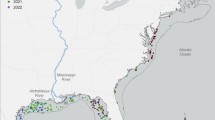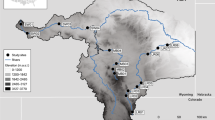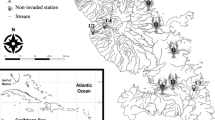Abstract
Biomass pyramids in natural food webs provide insights into multitrophic ecosystem functioning. We measured the integrated trophic position (iTP), which reflects the average efficiency of biomass transfer through trophic pathways, of 14 mesozooplankton communities in the western North Pacific. Compound-specific nitrogen isotope analysis of amino acids for composite mesozooplankton biomass indicated that the iTP values of marine mesozooplankton communities and their biomass pyramids are essentially controlled by biodiversity, body weight, and species turnover. Offshore communities with lower diversity and higher iTP were dominated by large copepods with slow turnover, such as Neocalanus, whereas nearshore communities with higher diversity and lower iTP were characterized by several smaller, fast turnover species belonging to Calanus, Paracalanidae, Eucalanidae, and Metridinidae. The observed iTP values (2.36 ± 0.32) indicate different topologies in biomass pyramids in different sites, where inverted pyramids are found in less diverse communities. The results also suggest that iTP can be linked to food chain length (FCL), a conventional proxy for the biomass pyramid. Combining iTP and FCL in the future studies will be a powerful approach to better understand factors controlling food web structure and dynamics.







Similar content being viewed by others
Data Availability
The data that support the findings of this study are available in the electronic supplementary material (ESM) of this article.
References
Arim M, Abades SR, Laufer G, Loureiro M, Marquet PA. 2010. Food web structure and body size: trophic position and resource acquisition. Oikos 119:147–153.
Basedow SL, De Silva NA, Bode A, Van Beusekorn J. 2016. Trophic positions of mesozooplankton across the North Atlantic: estimates derived from biovolume spectrum theories and stable isotope analyses. J Plankton Res 38:1364–1378.
Bonhommeau S, Dubroca L, Le Pape O, Barde J, Kaplan DM, Chassot E, Nieblas A-E. 2013. Eating up the world’s food web and the human trophic level. Proc Natl Acad Sci USA 110:20617–20620.
Chikaraishi Y, Kashiyama Y, Ogawa NO, Kitazato H, Ohkouchi N. 2007. Biosynthetic and metabolic controls of nitrogen isotopic composition of amino acids in marine macroalgae and gastropods: implications for aquatic food web studies. Mar Ecol Prog Ser 342:85–90.
Chikaraishi Y, Ogawa NO, Kashiyama Y, Takano Y, Suga H, Tomitani A, Miyashita H, Kitazato H, Ohkouchi N. 2009. Determination of aquatic food-web structure based on compound-specific nitrogen isotopic composition of amino acids. Limnol Oceanogr Methods 7:740–750.
Chikaraishi Y, Ogawa NO, Doi H, Ohkouchi N. 2011. 15N/14N ratios of amino acids as a tool for studying terrestrial food webs: a case study of terrestrial insects (bees, wasps, and hornets). Ecol Res 26:835–844.
Dagg M. 1993. Sinking particles as a possible source of nutrition for the large calanoid copepod Neocalanus cristatus in the subarctic Pacific Ocean. Deep Sea Res I 40:1431–1445.
Décima M, Landry MR, Bradley CJ, Fogel ML. 2017. Alanine δ15N trophic fractionation in heterotrophic protists. Limnol Oceanogr 62:2308–2322.
Elton CS. 1927. Animal ecology. Chicago: University of Chicago Press.
Garcia HE, Weathers K, Paver CR, Smolyar I, Boyer TP, Locarnini RA, Zweng MM, Mishonov AV, Baranova OK, Seidov D, Reagan JR (2018) World Ocean Atlas 2018, Volume 4: Dissolved Inorganic Nutrients (phosphate, nitrate and nitrate+nitrite, silicate). A Mishonov Technical Ed, NOAA Atlas NESDIS 84, 35pp
Gutiérrez-Rodríguez A, Décima M, Popp BN, Landry MR. 2014. Isotopic invisibility of protozoan trophic steps in marine food webs. Limnol Oceanogr 59:1590–1598.
Hannides CCS, Popp BN, Landry MR, Graham BS. 2009. Quantification of zooplankton trophic position in the North Pacific subtropical Gyre using stable nitrogen isotopes. Limnol Oceanogr 54:50–61.
Harrison PJ, Whitney FA, Tsuda A, Saito H, Tadokoro K. 2004. Nutrient and plankton dynamics in the NE and NW gyres of the subarctic Pacific Ocean. J Oceanogr 60:93–117.
Hatton IA, McCann KS, Fryxell JM, Davies TJ, Smerlak M, Sinclair AR, Loreau M. 2015. The predator–prey power law: biomass scaling across terrestrial and aquatic biomes. Science 349:aac6284.
Higashi M, Burns TP, Patten BC. 1989. Food Network unfolding: an extension of trophic dynamics for application to natural ecosystems. J Theor Biol 140:243–261.
Hirai J, Tachibana A, Tsuda A. 2020. Large-scale metabarcoding analysis of epipelagic and mesopelagic copepods in the Pacific. PLoS ONE 15:e0233189.
Hirata T, Hardman-Mountford NJ, Brewin RJW, Aiken J, Barlow R, Suzuki K, Isada T, Howell E, Hashioka T, Noguchi-Aita M, Yamanaka Y. 2011. Synoptic relationships between surface chlorophyll-a and diagnostic pigments specific to phytoplankton functional types. Biogeosciences 8:311–327.
Ikeda T, Shiga N, Yamaguchi A. 2008. Structure, biomass distribution and trophodynamics of the pelagic ecosystem in the Oyashio region, western subarctic Pacific. J Oceanogr 64:339–354.
Ishikawa NF. 2018. Use of compound-specific nitrogen isotope analysis of amino acids in trophic ecology: assumptions, applications, and implications. Ecol Res 33:825–837.
Ishikawa NF, Chikaraishi Y, Ohkouchi N, Murakami AR, Tayasu I, Togashi H, Okano J, Sakai Y, Iwata T, Kondoh M, Okuda N. 2017. Integrated trophic position decreases in more diverse communities of stream food webs. Sci Rep 7:2130.
Ishikawa NF, Ogawa NO, Chikaraishi Y, Yamaguchi MO, Fujikura K, Miyairi Y, Yokoyama Y, Nagata T, Ohkouchi N. 2021. Influences of ocean currents on the diets of demersal fish communities in the western North Pacific revealed by their muscle carbon and nitrogen isotopic compositions. Front Mar Sci 8:641282.
Kato Y, Kondoh M, Ishikawa NF, Togashi H, Kohmatsu Y, Yoshimura M, Yoshimizu C, Haraguchi TF, Osada Y, Ohte N, Tokuchi N, Okuda N, Miki T, Tayasu I. 2018. Using food network unfolding to evaluate food-web complexity in terms of biodiversity: theory and applications. Ecol Lett 21:1065–1074.
Kiørboe T. 2011. How zooplankton feed: mechanisms, traits and trade-offs. Biol Rev 86:311–339.
Kobari T, Ikeda T. 1999. Vertical distribution, population structure and life cycle of Neocalanus cristatus (Crustacea: Copepoda) in the Oyashio region, with notes on its regional variations. Mar Biol 134:683–696.
Landry MR, Gifford DJ, Kirchman DL, Wheeler PA, Monger BC. 1993. Direct and indirect effects of grazing by Neocalanus plumchrus on plankton community dynamics in the subarctic Pacific. Prog Oceanogr 32:239–258.
Layman CA, Winemiller KO, Arrington DA, Jepsen DB. 2005. Body size and trophic position in a diverse tropical food web. Ecology 86:2530–2535.
Liang D, Uye S. 1996. Population dynamics and production of the planktonic copepods in a eutrophic inlet of the Inland Sea of Japan. II1. Paracalanus sp. Mar Biol 127:219–227.
Lindeman RL. 1942. The trophic-dynamic aspect of ecology. Ecology 23:399–417.
Locarnini RA, Mishonov AV, Baranova OK, Boyer TP, Zweng MM, Garcia HE, Reagan JR, Seidov D, Weathers K, Paver CR, Smolyar I (2018) World Ocean Atlas 2018, Volume 1: Temperature. A Mishonov Technical Ed. NOAA Atlas NESDIS 81, 52pp
Matsubayashi J, Osada Y, Tadokoro K, Abe Y, Yamaguchi A, Shirai K, Honda K, Yoshikawa C, Ogawa NO, Ohkouchi N, Ishikawa NF, Nagata T, Miyamoto H, Nishino S, Tayasu I. 2020. Tracking long-distance migration of marine fishes using compound-specific stable isotope analysis of amino acids. Ecol Lett 23:881–890.
McCarthy MD, Benner R, Lee C, Fogel ML. 2007. Amino acid nitrogen isotopic fractionation patterns as indicators of heterotrophy in plankton, particulate, and dissolved organic matter. Geochim Cosmochim Acta 71:4727–4744.
McGowan JA, Walker PW. 1979. Structure in the copepod community of the North Pacific central gyre. Ecol Monogr 49:195–226.
Miyaguchi H, Fujiki T, Kikuchi T, Kuwahara VS, Toda T. 2006. Relationship between the bloom of Noctiluca scintillans and environmental factors in the coastal waters of Sagami Bay, Japan. J Plankton Res 28:313–324.
Motoda S. 1959. Devices of simple plankton apparatus. Mem Fac Fish Hokkaido Univ 7:73–94.
Nagasawa S, Marumo R. 1972. Feeding of a pelagic chaetognath, Sagitta nagae Alvariño in Suruga Bay, Central Japan. J Ocean Soc Jpn 28:181–186.
NOAA National Geophysical Data Center (2006) 2-minute gridded global relief data (ETOPO2) v2. NOAA National Centers for Environmental Information. https://doi.org/10.7289/V5J1012Q. Accessed 7 April 2021
Odate T. 1994. Plankton abundance and size structure in the northern North Pacific Ocean in early summer. Fish Oceanogr 3:267–278.
Ogawa NO, Chikaraishi Y, Ohkouchi N. 2013. Trophic position estimates of formalin-fixed samples with nitrogen isotopic compositions of amino acids: an application to gobiid fish (Isaza) in Lake Biwa, Japan. Ecol Res 28:697–702.
Pauly D, Christensen V. 1995. Primary production required to sustain global fisheries. Nature 374:255–257.
Pauly D, Christensen V, Dalsgaard J, Froese R, Torres F. 1998. Fishing down marine food webs. Science 279:860–863.
Pielou EC. 1966. Shannon’s formula as a measure of specific diversity: its use and misuse. Am Nat 100:463–465.
Popp BN, Graham BS, Olson RJ, Hannides CCS, Lott MJ, López-Ibarra G, others. 2007. Insight into the trophic ecology of yellowfin tuna, Thunnus albacares, from compound-specific nitrogen isotope analysis of proteinaceous amino acids. In: Dawson TE, Siegwolf RTW, Eds. Stable isotopes as indicators of ecological change, . Amsterdam: Elsevier. pp 173–190.
Purcell JE. 1981. Dietary composition and diel feeding patterns of epipelagic siphonophores. Mar Biol 65:83–90.
R Development Core Team. 2019. R: a language and environment for statistical computing. Vienna: R Foundation for Statistical Computing.
Sathyendranath S, Jackson T, Brockmann C, Brotas V, Calton B, Chuprin A, Clements O, Cipollini P, Danne O, Dingle J, Donlon C, Grant M, Groom S, Krasemann H, Lavender S, Mazeran C, Mélin F, Moore TS, Müller D, Regner P, Steinmetz F, Steele C, Swinton J, Valente A, Zühlke M, Feldman G, Franz B, Frouin R, Werdell J, Platt T (2020) ESA ocean colour climate change initiative (Ocean_Colour_cci): Global chlorophyll-a data products gridded on a sinusoidal projection, Version 4.2. Centre for Environmental Data Analysis. https://catalogue.ceda.ac.uk/uuid/99348189bd33459cbd597a58c30d8d10. Accessed 7 April 2021
Shannon CE, Weaver W. 1963. The mathematical theory of communication. Urbana: University of Illinois Press.
Takahashi K, Kuwata A, Saito H, Ide K. 2008. Grazing impact of the copepod community in the Oyashio region of the western subarctic Pacific Ocean. Prog Oceanogr 78:222–240.
Tsuda A, Saito H, Kasai H. 1999. Life histories of Neocalanus flemingeri and Neocalanus plumchrus (Calanoida: Copepoda) in the western subarctic Pacific. Mar Biol 135:533–544.
Tunney TD, McCann KS, Lester NP, Shuter BJ. 2012. Food web expansion and contraction in response to changing environmental conditions. Nat Commun 3:1105.
Ward CL, McCann KS. 2017. A mechanistic theory for aquatic food chain length. Nat Commun 8:2028.
Wilhm JL. 1968. Use of biomass units in Shannon’s formula. Ecology 49:153–156.
Yokouchi K, Takeshi K, Matsumoto I, Fujiwara G, Kawamura H, Okuda K. 2000. OCTS-derived chlorophyll-a concentration and oceanic structure in the Kuroshio frontal region off the Joban/Kashima Coast of Japan. Remote Sens Environ 78:188–197.
Acknowledgements
We are grateful to Haruko Umeda for identifying mesozooplankton species and screening the literature for feeding guilds; Yoko Sasaki for hel** with the laboratory work; Takeshi Okunishi for data input; Prima Anugerahanti, Sherwood Lan Smith, and Michio Kondoh for fruitful discussions; and Chisato Yoshikawa for valuable comments on the manuscript. Comments and suggestions from Martin Lindegren and an anonymous reviewer are greatly appreciated. We would also like to thank Enago for the English language review. This study was supported by the Japan Science and Technology Agency CREST (Grant Number JPMJCR13A4) and the Japan Society for the Promotion of Science Grants-in-Aid for Scientific Research (18H02513). We declare no conflict of interest.
Author information
Authors and Affiliations
Corresponding author
Supplementary Information
Below is the link to the electronic supplementary material.
Rights and permissions
About this article
Cite this article
Ishikawa, N.F., Tadokoro, K., Matsubayashi, J. et al. Biomass Pyramids of Marine Mesozooplankton Communities as Inferred From Their Integrated Trophic Positions. Ecosystems 26, 217–231 (2023). https://doi.org/10.1007/s10021-022-00753-w
Received:
Accepted:
Published:
Issue Date:
DOI: https://doi.org/10.1007/s10021-022-00753-w




